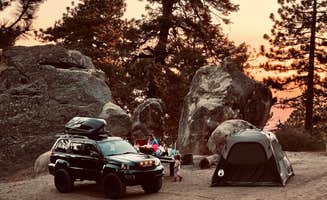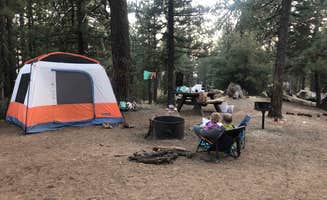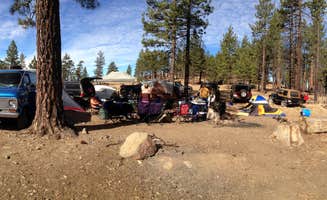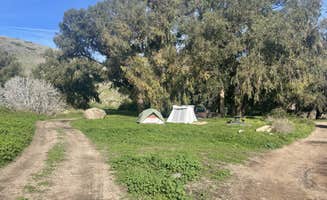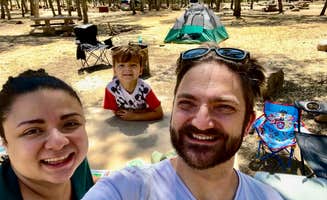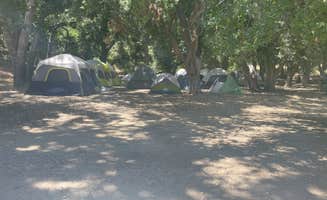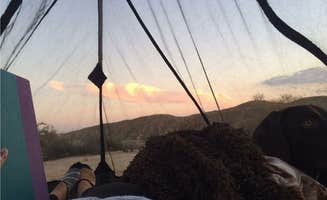Tent campsites near Oak View, California offer access to diverse ecosystems within Los Padres National Forest, where elevations range from sea level to over 8,800 feet at Mt. Pinos. Campers experience temperature variations of 30-40 degrees between coastal and mountain sites. Winter camping at higher elevations often requires snow gear, while coastal island camping maintains mild temperatures year-round.
What to do
Stargazing at high elevations: Chula Vista Campground at Mt. Pinos sits at nearly 9,000 feet with minimal light pollution. "I met a guy named Bob and helped set up his telescope in the parking lot, he let anyone who wanted check out the amazing night sky!" reports one camper. The parking area is popular with astronomers, so use dimmed headlights when arriving after dark.
Wildlife viewing on islands: At Santa Cruz Island Scorpion Canyon Campground, visitors can observe island foxes and marine life. "Foxes everywhere. Kayak around and experience seals and dolphins right underneath you in beautiful coves," notes a camper. The island's isolation creates unique wildlife viewing opportunities not available on the mainland.
Hiking network access: Oak Flat Campground provides direct access to the Sespe Trail system. "We camped right before Oak flat and right along the Sespe river (15 yards away). We filled up our water at a spot about 39 yards upstream, just bc it's flowing better," explains a backpacker who accessed the wilderness trail system from this area.
What campers like
Complete disconnection: Santa Cruz Island camping offers rare technology-free experiences. "What a fantastic getaway! The Channel Islands offer some of the most remote camping, and it's easy to do," shares one visitor. The boat trip to reach the island creates a natural barrier from everyday distractions.
Moderate year-round climate: Danielson Group Multi-Use Area receives praise for its spring conditions. "We have been camping this site every Spring for about 6 years. Everyone always loves it! Facilities are clean and well maintained, the area is safe, electricity on light poles, running water," notes a regular visitor. Spring brings wildflowers and green landscapes.
Free camping options: Chula Vista Campground provides no-cost tent sites with basic amenities. "Plenty of sites. Old rustic bathrooms work well. Picnic tables at each site. Brought my dogs here and they had a blast, plus no ticks found," shares a camper who appreciated the value and cleanliness of this free campground.
What you should know
Permit requirements: Several sites require permits or passes. "Ranger woke me up early asking for a permit. He explained a shell station off the 176 nearby sells $5 day passes and $30 annual," reports a camper at Oak Flat Campground. Adventure Passes or America the Beautiful passes are accepted at most Los Padres National Forest sites.
Limited or no water sources: Many tent sites require campers to bring all water. "No water spigots, bring your own," notes an Oak Flat visitor. Channel Islands camping provides potable water at designated spigots, but campers still need to carry containers from the water source to their sites.
Seasonal access limitations: Higher elevation campgrounds close during winter. "Way up near the Reyes Peak Trailhead, 6 sites right on the ridge. Vault toilet. Picnic tables. No water," explains a visitor to Reyes Peak Campground, which typically operates from April through November due to snow closures.
Tips for camping with families
Island camping preparation: When visiting Santa Cruz Island with children, bring appropriate gear for the half-mile walk from the landing area. "The campgrounds have clean restrooms and plenty of fresh water so its perfect for families. The group sites are quite large and more secluded in the upper level," advises a family camper. Children should be monitored around island wildlife.
High elevation options: Reyes Peak Campground offers family-friendly sites with cooler temperatures during summer heat. "Love the proximity to Santa Barbra. And a fun place to check out with amazing views of the islands," notes a visitor who recommends bringing sun protection for the exposed sites.
Group camping facilities: Danielson Multi-Use Area accommodates family reunions with extensive facilities. "Young kids to elderly adults. Everyone always loves it! Facilities are clean and well maintained, the area is safe, electricity on light poles, running water, use of massive fireplace, lots of shade, plenty of tables, climbing trees," reports a repeat visitor who brings 15-40 family members annually.
Tips from RVers
Road access challenges: Rancho Nuevo Campground may require additional hiking during seasonal gate closures. "We had to walk about a mile and a half to the campground as the seasonal gate was closed," reports a visitor. RVers should check road conditions and gate status before attempting access to remote campgrounds.
High clearance recommendations: The dirt roads leading to many Los Padres National Forest campgrounds become rutted after rain. "The road to get down can be difficult depending on what the weather has been like," warns a visitor to Lions Canyon. Small RVs and trailers may access some sites, but large rigs won't fit on most forest roads near Oak View.


